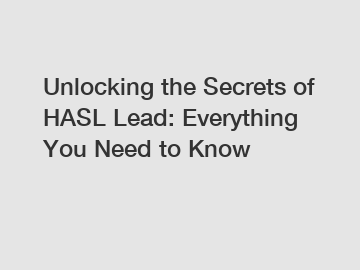Unlocking the Secrets of HASL Lead: Everything You Need to Know.
Printed circuit boards (PCBs) are essential components in electronic devices, serving as the foundation for electrical connections. Among the many processes used in PCB fabrication, Hot Air Solder Leveling (HASL) is a popular choice due to its reliability and cost-effectiveness. HASL lead, in particular, is commonly used in PCB assembly. In this article, we will delve into the world of HASL lead, uncovering its secrets and providing you with everything you need to know.
Understanding HASL Lead.

HASL lead refers to the use of a lead-tin alloy to plate the exposed copper on a PCB, creating a solderable surface that allows electronic components to be attached securely. The process involves applying a layer of molten solder to the PCB, which is then leveled using hot air, hence the name Hot Air Solder Leveling. The primary purpose of HASL lead is to provide a reliable solder joint between the components and the PCB during assembly.
Advantages of HASL Lead.
One of the primary advantages of using HASL lead is its cost-effectiveness. Compared to other surface finishes like ENIG (Electroless Nickel Immersion Gold) or OSP (Organic Solderability Preservatives), HASL lead is more affordable, making it an attractive option for mass production of PCBs. Additionally, HASL lead provides a good level of solderability and shelf life, ensuring that the PCBs can be stored for an extended period without losing their solderability.
Challenges of HASL Lead.
While HASL lead offers several advantages, it also comes with its own set of challenges. One of the main concerns with HASL lead is the uneven surface that can be created during the leveling process. This uneven surface can lead to issues with component placement and solder joint quality. Additionally, the presence of lead in the solder alloy raises environmental and health concerns, prompting many manufacturers to seek lead-free alternatives.
Choosing the Right Surface Finish.
When selecting a surface finish for your PCB, it is essential to consider the specific requirements of your application. While HASL lead is a popular choice for its cost-effectiveness and reliability, there are other options available, such as ENIG, OSP, and immersion tinimmersion tin, each offering their own set of benefits and limitations. By understanding the needs of your project and the properties of each surface finish, you can make an informed decision on the best option for your PCB assembly.
Conclusion.
In conclusion, HASL lead is a widely used surface finish in PCB fabrication, offering a balance of cost-effectiveness and reliability. By understanding the process and advantages of HASL lead, you can make informed decisions when selecting a surface finish for your PCBs. While there are challenges associated with HASL lead, its benefits make it a popular choice for many applications. If you have any questions or would like to learn more about HASL lead and other PCB surface finishes, please contact us.
Contact us: [Insert contact information here].
For more information, please visit hasl lead free, Industrial Control PCB Manufacturer.



Comments
All Comments (0)